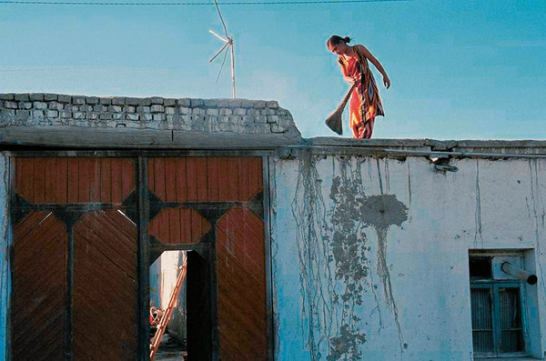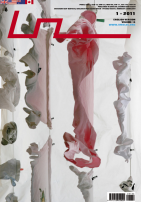| Umělec magazine 2011/1 >> Umida Akhmedova - Accused | List of all editions. | ||||||||||||
|
|||||||||||||
Umida Akhmedova - AccusedUmělec magazine 2011/101.01.2011 Alexey Ulko | in transition | en cs de ru |
|||||||||||||
|
The young Soviet Union in the 1920’s and 1930’s instigated the national-territorial delimitation of the republics of Central Asia so that the region previously known as the Russian Empire would conform to Stalin’s proscribed policy, as laid out in Marxism and the National Question, that a nation was, “a historically constituted, stable community of people formed on the basis of a common language, territory, economic and psychological life manifested in a common culture.” The lack of imagination among the Soviet leaders shown in the creation of these Soviet Socialist Republics backfired on the nation states with their suddenly obtained independence in 1991. Where before there had simply been the block of countries known under the collective title of the Union of Soviet Socialist Republics, there now emerged on the map as many as five new ‘-stans’: Kazakhstan, Kyrgyzstan, Tajikistan, Turkmenistan and Uzbekistan—countries which can only rarely be confidently distinguished by anyone except those of their own population and experts in international relations. On the one hand this situation provoked an active search for their inner identity, which soon made apparent some of the features that characterize these states today: the freedom-loving, but regularly torn by internal strife Kyrgyzstan; Turkmenistan foundering in the absolute neutrality of its grotesque self-isolation and the stable Uzbekistan most faithfully preserving all the features of the Soviet system. On the other hand, all of these states are characterized by a heightened sensitivity to the perception of their image in the eyes of the world community. A striking illustration of this was the reaction of the Kazakh public who, not being prone to self-irony, were incensed by the movie Borat, written by the comedian Sasha Baron Cohen in which he allegedly ridicules the Kazakh people and which, on its release, included a protest note from the Ministry of Foreign Affairs, yet the film was followed by a considerable increase in the number of incoming tourists to the country. Both of these factors are most relevant to our topic, but let us dwell on this later.
However, the Central Asian countries, basing themselves on the experience and style of Soviet statehood, have regained some half-forgotten commonness in their relation to the past. The vacuum, which was created after the Soviet ideology had become history, was quickly filled with a diverse and eclectic collection of new national ideologies, mentalities, and traditions. An important, if not fundamental characteristic of all these new conceptions, was their malleable use of the past. Indeed, the genuine historical process does not fit the artificiality of the new state, which has suddenly gained its ‘perfect structure’. Balancing the age-old aspirations of the people requires a certain negation of historical fact so that such a state can only be seen to have achievements. Accordingly, this appeal to the past is of a blatantly mythological nature, such as: there is no concept of ‘the Turks’, there is the concept of ‘the Turkmen’ instead; the origin of the Kazakh statehood dates back to the second millennium BC; the Samanids are the Tajik Aryan Empire of the 10 century, and so on. The place of history is occupied by the immutable and yet amorphous concept of these, “sacred national traditions.” This certainly has a decisive influence on creative activities in the region: it is less prevalent in the countries with nomadic traditions and stronger in the states that emerged on the basis of various forms of settled life. Inherited from the Soviet system, the ‘official’ art glorifies those figures that are meticulously selected for mythologizing, whether of the past (Gorogly, Timur, Samani) or the present (‘the Nation’s Leader’ President Nazarbayev, ‘the Turkmens’ Father’ President Niyazov). A little aloof, but still in the mainstream of official policy, there are those numerous and similar works that praise the beauty of the national rituals, ceremonies and everyday life. Others seek recognition in the less mythologized ‘West’ and try to adequately express the same “national mentality” by means of installations, collages and conceptual art that has been regularly stuffing the galleries around the world for the past fifty years. This, of course, does not mean that the region has no artists who are sincerely and deeply engaged in actual creative research matters. But, simply said, such artists face the risk of not fitting into the existing, although admittedly not too refined, conformist framework, which in the current political and ideological climate can threaten them with serious problems. This fully applies to Uzbekistan, a country which had grown at the crossroads of the Great Silk Road and was imbued with the culture and traditions of many peoples and inherited both their achievements and their complexities. Unfortunately, an open and honest artist’s look at the multi-dimensional reality of the modern Uzbek society is not only unwelcome, but also severely punished. This was fully felt by the famous photo and video documentary artist, Umida Akhmedova. A graduate of the RF State Institute of Cinematography, the first camerawoman in Uzbekistan and a participant and the curator of numerous international projects, who, under the verdict of the Mirabad Criminal Court of Feb. 10, 2010, was—again for the first time ever in the national history—convicted under Article 139/3g (defamation) and Article 140/2 (insult) of the Criminal Code of Uzbekistan. And although under the decision of the same court Akhmedova was freed from the punishment, all further appeals failed to make the court overturn their decision. The formal grounds for the conviction was the participation of Akhmedova in the Gender Programs, supported by the Swiss Embassy, which led to the creation of a photographic album, Women and Men: from Dawn to Dusk and the documentary The Burden of Virginity, co-authored by Akhmedova and her husband, Oleg Karpov. While monitoring these programs, the attention of the employees of the Uzbek Agency for Communication and Information was attracted by a number of materials, including the photo album and the documentary by Akhmedova as possibly offensive for the mentality and dignity of the Uzbek people, defamatory and sullying the Uzbek people’s good name. Basing their conviction on the decision of a specially gathered expert commission, they initiated a criminal case against Umida Akhmedova. There is no need to dwell on the legal process against Akhmedova, because actually there was no ‘process’ in her case—the absurdity and groundlessness of the accusations, visible even to the naked eye, did not prevent the court from holding several formal hearings and imposing the initially prejudged conviction. The best evidence of the level and nature of the plaintiffs’ argumentation is the transcript of the expert opinion on some of the pictures, placed in the album: “The album “Women and Men: from Dawn to Dusk” presents 111 photos by Umida Akhmedova. 90% of the photos were taken in remote and backward kishlaks, and the author’s aim was to show the heavy side of life. Moreover, Umida Akhmedova depicts our national ceremonies in dark colors. For example, a weeping girl says goodbye to her father, wanting his blessing. But then we see the hands of the bride, standing very uncertain, and her husband’s fist next to her. At first glance the two pictures seem quite common. But by these two photos the photographer wants to say that the girl, having got married, has completely lost her freedom and is crying, saying goodbye to her father. In Europe brides do not cry when they are getting married. Therefore, any Western man looking at this picture will definitely think that in Uzbekistan girls are forced to get married, and so they cry. The lens of Umida Akhmedova does not reflect beautiful places, modern buildings, and well-off villages. This person sees a woman in a phone booth waiting for clients, a woman with wet hair selling carpets, and a flower girl looking pensively at the camera. In the photographs women are occupied only with daily concerns and hard work. While men are mostly occupied with bravados, cock fighting, eating plov and enjoying themselves. Simply put, life is shown there very ugly. The photo album does not meet the aesthetic requirements. In short, it is necessary to stop the spread of this album among the general public.” The critical feature of the accusations brought against Umida Akhmedova was not even their full legal inconsistency and initial absurdity, culminating in this grotesque display. Thus, when the defense made the statement that, defamation and insult, according to the Criminal Code of Uzbekistan, may be recognized as such only if they imply and address specific individuals, the prosecution responded that the entire Uzbek people consists of individuals, that is why everyone of them is subjected to the insult and defamation on the part of Akhmedova. Equally frightening, absurd and paranoid was the authorities’ fear of this mythical, “erroneous opinion of the West,” based on the lack of faith of the ‘experts’ in the ability of tourists from Europe to be able come to a conclusion alone, that not all the life of the Uzbek people takes place under the shadow of the Tashkent fountains against the backdrop of the glamorous boutiques. Curiously, the real opinions of hundreds of people from around the world, who expressed their indignation against the criminal prosecution and supported the creative work done by Akhmedova as, “truthful, honest and imbued with love and concern for her people,” was not at all interesting for the prosecution. As a result, according to one of the foreign diplomats accredited in Uzbekistan, “the process against Akhmedova has clearly demonstrated to the world the futility of the efforts taken by the country’s leadership to present it as a democratically developing country. It is difficult even to estimate the damage caused by this farce to the image of Uzbekistan.” In conclusion, we would like to note, that in our opinion the most disturbing aspect of the case of Umida Akhmedova has not been the violation of the rights for the freedom of creativity, nor the unsubstantiated nature of the accusations and not even the conviction for defamation and insult imposed on the artist; who has touched with compassion the well-known, but frequently ignored aspects of the life of her people. The photos and films by Akhmedova did not manifest to the world any unheard of or mythical information about the hard plight of the Uzbek people, or about their cruel rites. The images’ strength lies in the fact that by simple and expressive means of art Akhmedova managed to defy the slowly inoculated, amorphous and false myths that hide behind the phrase, “the national ideology.” Refusing to follow the historically artificial doctrine of the inviolability and sanctity of ‘the national traditions’, Akhmedova draws attention to the facts of the Uzbek people’s real life in all their diversity, and opposing the obscurantist ideas about the, “sanctity of the national spirit,” which we thought we had done away with forever in 1945. Translated from Russian by Elena Dyuldina.
01.01.2011
Recommended articles
|
|||||||||||||















Comments
There are currently no comments.Add new comment